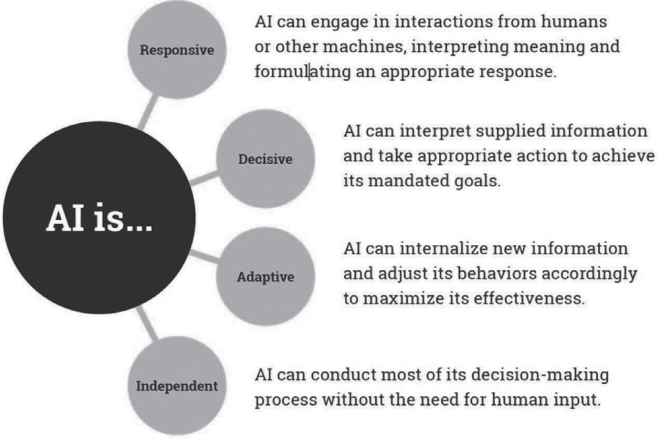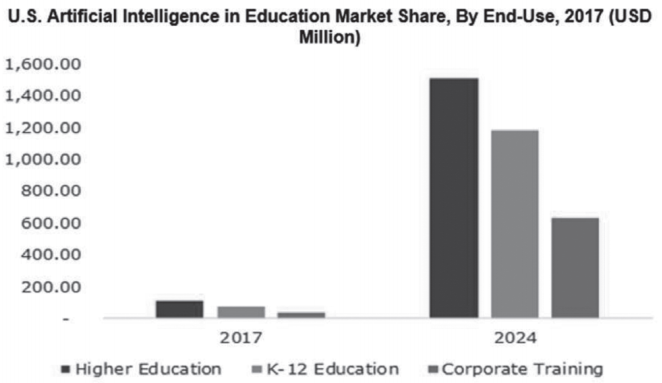Krzysztof Nesterowicz: Artificial Intelligence as an Opportunity for Public Administration Education (IJ, 2023/1. (80.), 23-26. o.)
Abstract
Artificial Intelligence (AI) is a system's ability to interpret correctly external data, learn from such data, and use this learning to achieve different goals through flexible adaptation. Recently, more and more implementations of AI in e-learning are available, e.g. intelligent tutoring systems. This paper discusses how to include AI in the current state of public administration education curriculum and decision processes.
Background
Artificial intelligence is intelligence displayed by machines, in opposition to natural intelligence shown by people and animals. AI textbooks define the topic as the study of intelligent agents, which are any devices that understand their surroundings and take actions to maximise their chances of success [Poole, Mackworth, Goebel, 1998]. An expanded definition of AI is as follows: "system's ability to correctly interpret external data, to learn from such data, and to use those learnings to achieve specific goals and tasks through flexible adaptation" [Kaplan, Haenlein, 2019]. AI is described as being responsive, decisive, adaptive, and independent (Figure 1).

Figure 1. Basic characteristics of artificial intelligence [Bates, 2018].
AI can monitor a user's progress and utilise that data to modify the present educational materials, creating a more individualised learning environment. Artificial intelligence may monitor how students are doing in an online course, identifying any areas in which they are falling short, and modifying the curriculum accordingly [Kolagani, 2019].
Neelakandan demonstrates a few ways an AI-based e-learning platform might enhance online education [Neelakandan, 2019]:
1) Real-time questioning
One of the most important capabilities of an AI-based e-learning platform is its capacity to serve as a teacher and provide real-time responses to queries. Students can ask inquiries and receive prompt answers on a subject thanks to AI.
2) Generate new course content
Course content preparation is one of the time-consuming aspects of e-learning. AI systems that have been appropriately trained can assist with data extraction and conversion into smart content for online learning. It enables experts to concentrate on developing an engaging digital learning experience for their learners.
3) Customised teaching session
E-learning is advantageous to teachers because it enables them to create content that can be sent to a variety of students. It is practically difficult for a lecturer to address the needs of all learners at once. In order to assess a learner's prior performance and ascertain his preferred learning style, artificial intelligence is crucial. AI uses the data to enhance the new learning content before providing the personalised learning experience that learners are looking for.
4) Gamification
A crucial tool used in online learning is gamification, which encourages and engages students to learn new things [Szakos, Szádeczky, 2022]. Gamification approaches can increase student motivation, engagement, commitment, and loyalty through the use of game mechanisms [Nesterowicz et al., 2022]. Duolingo is one of the world's most popular language-learning apps. Its gamified concept includes competitiveness via levels and points, daily reminders, and even a social generation component via online discussion forums [Källqvist, 2019]. Lok states that "the demand for gamification has boomed. According to The Huffington Post, over 350 companies, including the likes of NBC and Panera, have invested in major gamification programmes for their respective media" [Lok, 2019].
Using AI in education is expected to increase significantly in the global market. The market for primary and secondary education, postsecondary education, and corporate training is only predicted to grow by more than half to $3.4 billion in the U.S. by 2024 (Figure 2) [Molnar, 2018].
Artificial Intelligence in Public Administration
The OECD's Digital Government Policy Framework is a framework that aids in the development of a strategic approach to achieve higher levels of digital maturity. It is required to go from e-government to digital governance in order to attain digital transformation. Previously, IT solutions were deployed to increase efficiency - to assist internal procedures - but today the goal is to digitalise the whole public sector. The aim is to alter services while also providing high-level collaboration with stakeholders [Fejes, Futó, 2021]. The analysis of 250 cases from throughout the European Union revealed that improving public service delivery is where AI is most often employed, followed by improving internal management and only in a small number of situations does it directly or indirectly enhance policy decision-making. The analysis reveals that various AI technologies and applications are utilised in various governance roles, emphasising the need for more thorough research to comprehend the function and effects of use in what is being referred to as the governance "of, with, and by AI" [van Noordt, Misuraca, 2022].
- 23/24 -

Figure 2. U.S. Artificial Intelligence in education market share [Molnar, 2018].
Government management necessitates the processing of far more data than most commercial organisations. As a result, new technologies such as AI can play an important role in the modernisation and general enhancement of government operations. At the same time, a guarantee of the processed data's openness, accuracy, and security is essential. As a result, the legality principle and the requirement to assure a high level of dependability of technologies utilised, as well as the necessity to protect citizens' rights, limit the use of AI in public administration [Wierzbowski, 2022]. The data transmission between the government website and the citizen's web browser includes usually some sharing of personal information. The way to secure this communication relies on the corresponding government body [Szakos, Szádeczky, 2019].
Impact of Artificial Intelligence in Enhancing Virtual Learning Environment
A virtual learning environment (VLE) for online learning is a system that includes educational materials like audio files, videos, chat sessions, texts, articles, forums, case studies, and exercises. All of these materials interact with the student using language to encourage learning (Figure 3) [Solano, 2010; Lavigne et al., 2015]. These systems include tools for communication, cooperation, evaluation, and student tracking. It is frequently useful for students enrolled in part-time courses, part-time workers, and distance learners. Making course content accessible through the institution's online resource centre is the common practise used in VLE [Kavitha, Lohani, 2019].
A teljes tartalom megtekintéséhez jogosultság szükséges.
A Jogkódex-előfizetéséhez tartozó felhasználónévvel és jelszóval is be tud jelentkezni.
Az ORAC Kiadó előfizetéses folyóiratainak „valós idejű” (a nyomtatott lapszámok megjelenésével egyidejű) eléréséhez kérjen ajánlatot a Szakcikk Adatbázis Plusz-ra!

